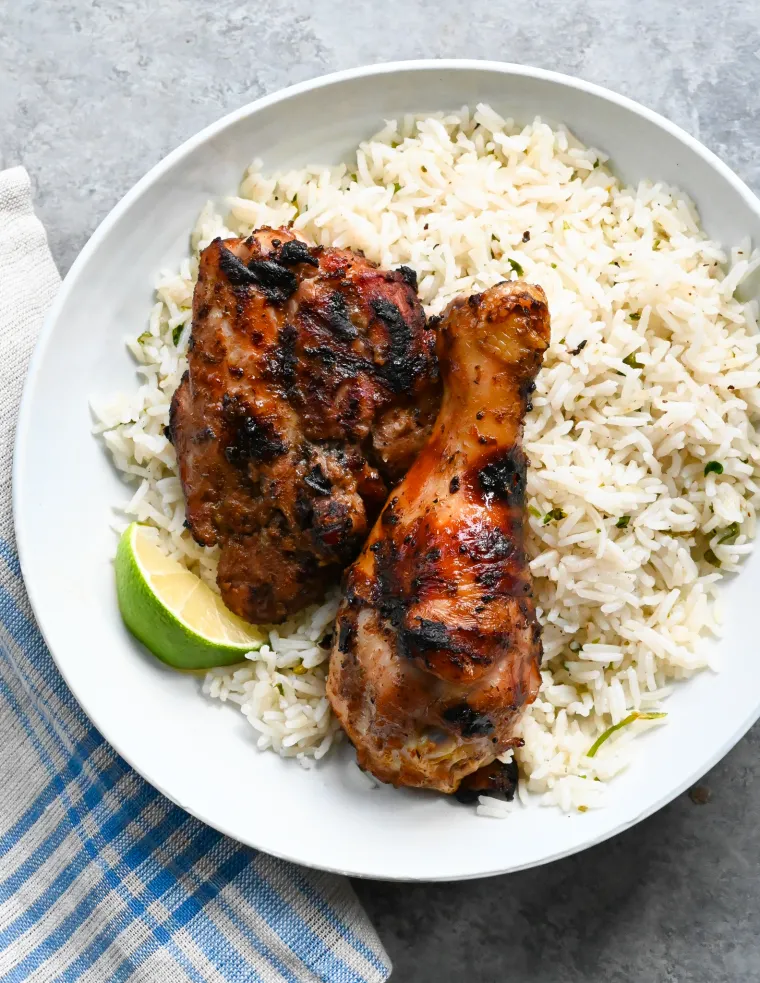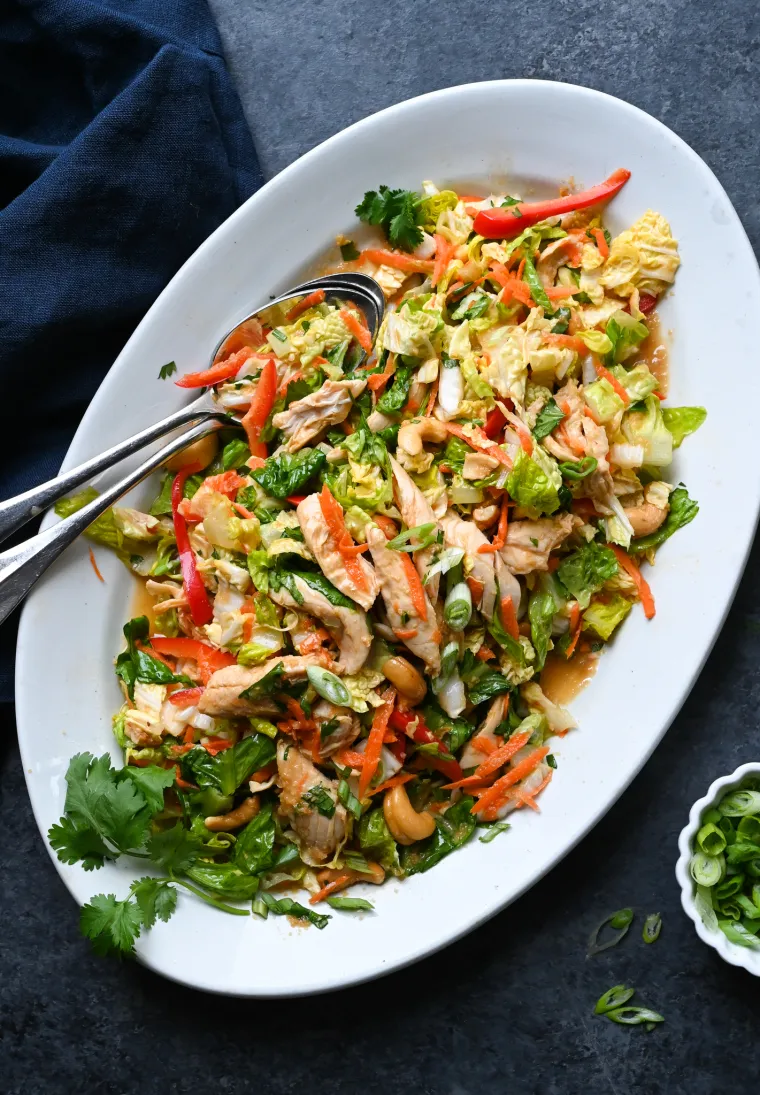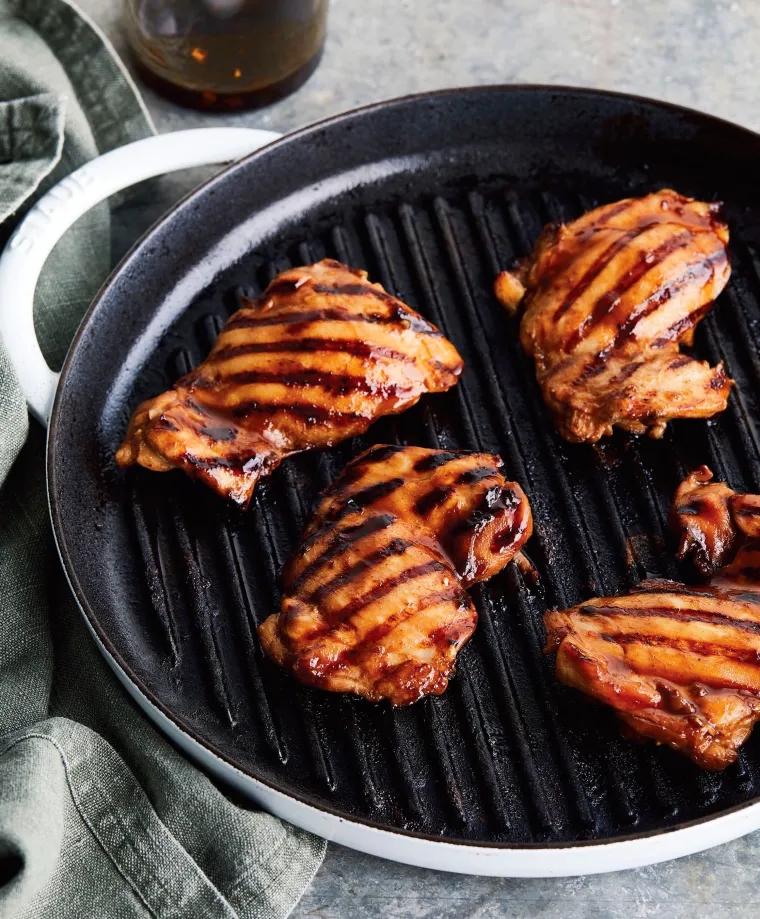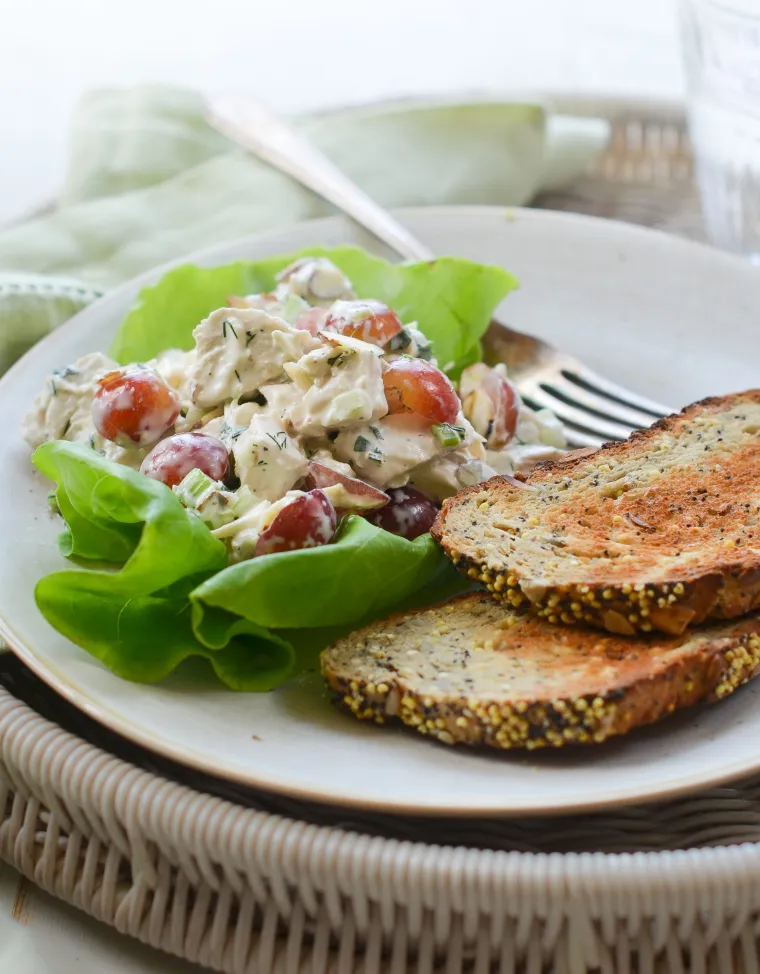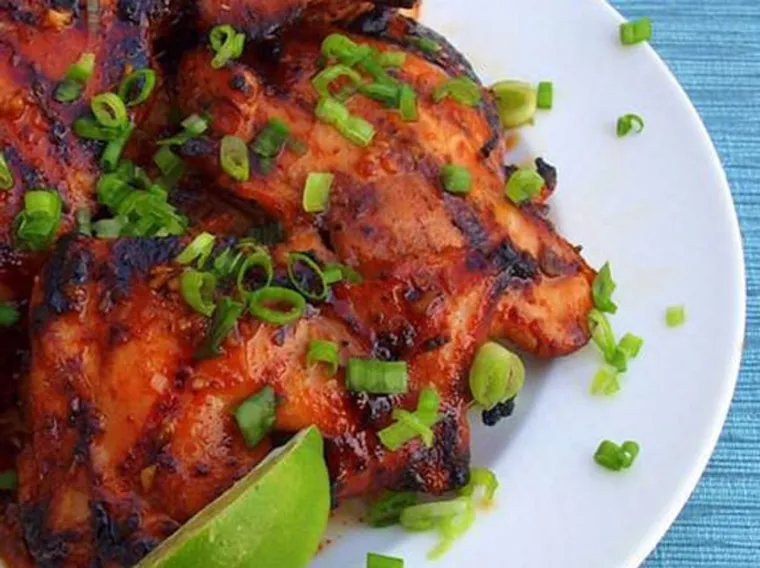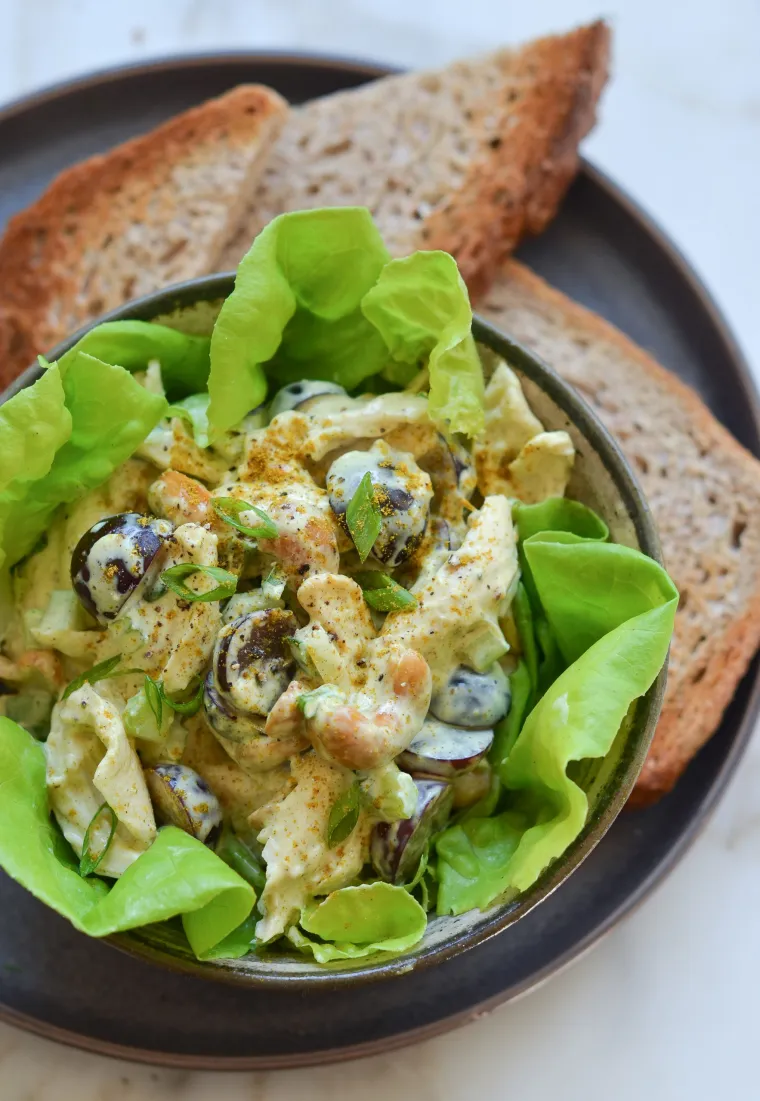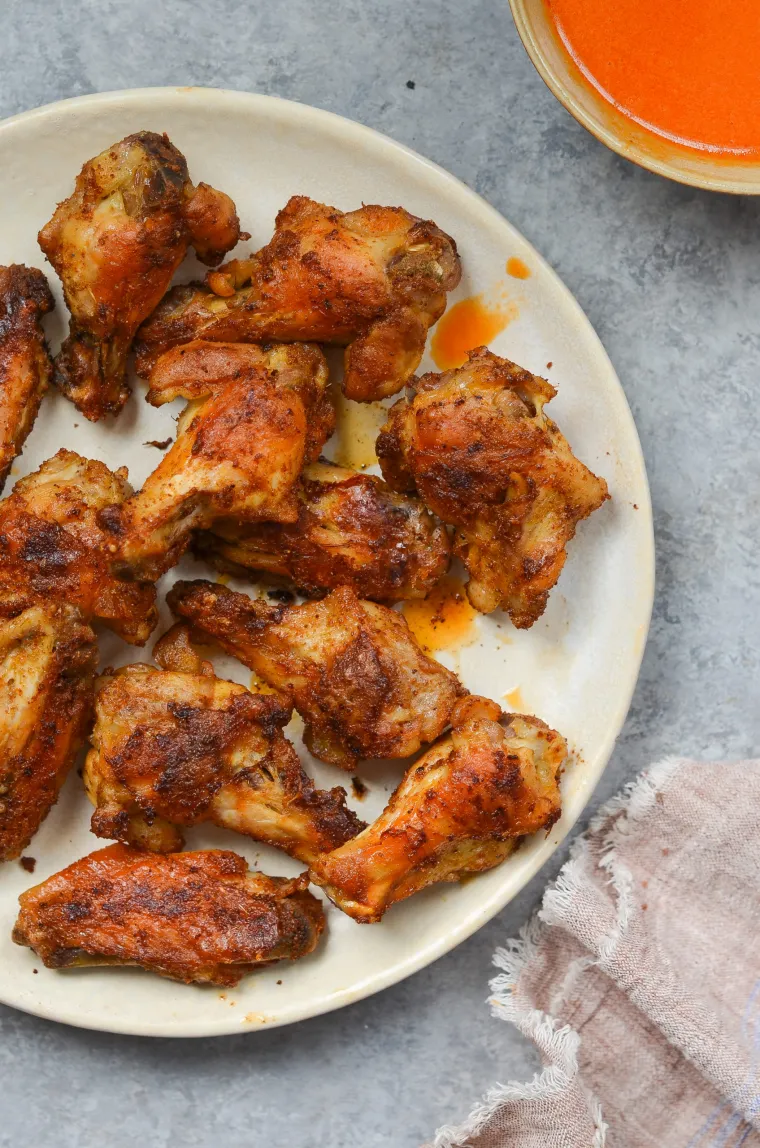Articles contributed by the community, curated for your enjoyment and reading.
Filters
Reset
Spicy, smoky and aromatic, Jerk chicken is Jamaica’s most iconic dish.
Jerk is a style of cooking native to Jamaica. Some people believe the term comes from the word charqui, a Spanish term for jerked or dried meat, which eventually became jerky in English; others claim it’s related to the constant turning or jerking of the meat to load it with the spice blend and cook it thoroughly. The ingredients for jerk chicken marinade – soy sauce, allspice, nutmeg, Chinese 5-spice powder, and Scotch bonnet peppers – exemplify Caribbean cooking, which is a distinct blend of African, European, Indian, and Asian flavors. This grilled jerk chicken recipe, adapted from Food & Wine, is my go-to recipe. It’s spicy, but you can tone down the heat level by removing the seeds and membranes from the hot peppers.
For best results, marinate the chicken overnight. The marinade is also great on beef, pork, or shrimp (although for shrimp, marinate for only 30 minutes to 1 hour), so feel free to double and freeze it for other uses. If you don’t have a grill (or grilling weather), the chicken can be roasted in the oven instead.
What You’ll Need To Make Jerk Chicken
Before we get to the step-by-step instructions, a few notes on the ingredients:
I recommend using bone-in chicken thighs and drumsticks over bone-in breasts for this recipe; the flavor is better and they are easier to grill without drying out. If you’d like to use bone-in chicken breasts, look for smaller ones so they won’t burn on the outside before the inside is fully cooked. Or, start them on the grill and finish them in the oven.
The recipe calls for either Scotch bonnet or habanero peppers. These two peppers are varieties of the same chili pepper species, and they have a similar flavor and level of heat. Scotch bonnet peppers are native to the Caribbean and are used to make authentic jerk chicken, but they can be hard to find; habanero peppers, grown primarily in Mexico, make a great substitute. The heat comes from the seeds and membranes, so throw in the whole peppers for spicy jerk chicken. For a milder dish, remove the seeds and membranes from one or both of the peppers.
Be very careful when working with hot peppers. If you touch your eyes while handling them, it will be very painful. It’s a good idea to wear disposable gloves or wash your hands very well when you’re done.
Step-by-Step Instructions
Begin by making the marinade. Combine all of the ingredients except for the chicken in a food processor.
Process until the vegetables are finely pureed.
Place the chicken and marinade in a Ziploc freezer bag and let it marinate in the refrigerator at least eight hours or overnight.
Preheat the grill to medium heat (about 350°F). Clean and oil the cooking grate. Place the chicken, skin side up, on the cooler side of the grill and cook, covered, turning and moving occasionally to prevent burning and flare-ups, for 35 to 40 minutes.
If the skin is not yet crispy, move the chicken, skin side down, to the hotter side of the grill; cook, keeping a close watch to prevent burning, until the skin is rendered and crisp, a few minutes.
If the skin is not yet crispy, move the chicken, skin side down, to the hotter side of the grill; cook, keeping a close watch to prevent burning, until the skin is rendered and crisp, a few minutes.
How To Cook Jerk Chicken In The Oven
As mentioned above, jerk chicken can be roasted in the oven if a grill is unavailable. Preheat the oven to 425°F and set an oven rack in the middle position. Line a baking sheet with aluminum foil for easy clean-up, and set an oven-proof rack on top. Spray the rack with nonstick cooking spray. Place the chicken on the rack, skin side up, and roast until lightly browned and cooked through, 40 to 45 minutes. Turn on broiler (leave the pan on the middle rack), and cook 1 to 3 minutes more, or until the skin is golden brown and crispy.
If you happen to have leftover chicken, it’s delicious in tacos, wraps, quesadillas, or burrito bowls.
Note: This recipe has been written by Jenn Segal and republished on MudMatter with Author’s Permission. Please find the original link here – Grilled Jerk Chicken.
Make a restaurant-quality Chinese chicken salad at home with this easy recipe featuring crisp veggies and tender chicken tossed in a delicious sesame-ginger dressing.
Chinese chicken salad is a California-style dish that perfectly blends the flavors of Chinese and American cuisine. Although it was a trendy restaurant menu item in the 1990s, for me, it’s a timeless favorite that will never go out of style. In fact, I would happily eat a salad like this every night of the week if I didn’t have a family to feed! The combination of fresh veggies, like Napa cabbage, crunchy carrots, and crisp bell peppers, combined with tender chicken and a sesame-ginger dressing make for a light and refreshing meal that always leaves you feeling satisfied. In this version, I’ve swapped out the traditional fried wonton strips with nuts to make the salad a bit healthier. However, if you prefer the crispy crunch of wontons, go ahead and add them in! The recipe is very easy to throw together, especially if you use leftover or rotisserie chicken instead of cooking your own — give it a try to see why it’s one of my all-time favorites!
What You’ll Need To Make Chinese Chicken Salad
Step-by-Step Instructions
Make the dressing: In a food processor or blender, combine all of the dressing ingredients.
Blend until smooth.
Assemble the salad: Combine all of the salad ingredients in a large bowl.
Add dressing, little by little, and toss to combine, until the salad is dressed to your liking.
Taste and adjust seasoning if necessary. Serve immediately.
Note: This recipe has been written by Jenn Segal and republished on MudMatter with Author’s Permission. Please find the original link here – Chinese Chicken Salad.
Andrea Nguyen’s savory-sweet char siu chicken is easy to make and hard to resist.
This easy char siu chicken recipe comes from Vietnamese Food Any Day: Simple Recipes for True, Fresh Flavors by Andrea Nguyen. Nguyen writes, “Savory-sweet and garlicky Chinese barbecued pork, called char siu in Cantonese and xá xíu in Vietnamese, is hard to resist. Since the classic porky version requires a good hour (better yet, overnight) to marinate, my weeknight approach is to make it with chicken thighs and grill it for a wonderful old-school flavor…Enjoy char siu chicken for dinner with rice and a quick stir-fried vegetable or a salad. Use leftovers (or make a double batch) for banh mi, a noodle soup, or fried rice.” My only tweak to the recipe was to increase the quantities and double the sauce because it’s that good.
What You’ll Need To Make Char Siu Chicken
The nice thing about this recipe is that very little prep is required; most of the ingredients come out of bottles and jars. The most time-consuming part of the recipe is trimming the chicken thighs (I find it easiest to use sharp kitchen shears). If you don’t want to use dark meat, go ahead and use chicken tenderloins. Just keep in mind that they’ll cook in half the time and you’ll need slightly less since they don’t need to be trimmed.
How To Make Char Siu Chicken
In a large bowl, stir together the garlic, five-spice powder, honey, hoisin, soy sauce, ketchup, and sesame oil.
Remove about half the marinade and set aside for glazing the chicken. Add the chicken to the bowl, coating the pieces well. Cover with plastic wrap and marinate at room temperature for 30 minutes, or refrigerate up to 24 hours (return to room temperature before cooking).
Lightly oil a cast-iron stove-top grill pan and set over medium-high heat. Add the chicken and cook for 6 to 10 minutes, turning several times. To test for doneness, pierce the flesh with the tip of a knife; the chicken is cooked when clear juices flow out. During the last 2 minutes, when the chicken feels firmish, baste with the reserved marinade to freshen flavor and add sheen.
Alternatively, prepare a medium charcoal fire or preheat a gas grill to medium and cook the chicken for 10 to 12 minutes, basting during the last 3 minutes. Transfer to a platter and let rest for 5 to 10 minutes before serving.
Note: This recipe has been written by Jenn Segal and republished on MudMatter with Author’s Permission. Please find the original link here – Char Siu Chicken.
This savory-sweet chicken salad is delicious in a sandwich, scooped over greens, or eaten straight from the bowl.
Back in May, The Kitchn published a fun chicken salad showdown by Amelia Rampe, pitting recipes from The New York Times, Southern Living, Ina Garten, and The Pioneer Woman against one another in the name of finding the best chicken salad on the internet. Each recipe uses a different method for cooking the chicken, different mix-ins, and different dressings. The Pioneer Woman’s savory-sweet chicken salad with grapes, almonds, and dill was crowned the winner, with Ina Garten’s recipe coming in a very close second. I loved both recipes, so I took what I liked from each, added a few touches of my own, and combined them into a version that’s delicious on a sandwich, scooped over greens, or eaten straight from the bowl. This is the fun of cooking!
What You’ll Need To Make Chicken Salad with Grapes and Almonds
Step-by-Step Instructions
Preheat the oven to 425°F and set an oven rack in the middle position. Line a baking sheet with aluminum foil. Rub the chicken with the oil and sprinkle with 1 teaspoon salt and 1/2 teaspoon pepper.
Roast for 25 to 30 minutes, or until or until a thermometer inserted into the thickest part of the breast reads between 160°F and 165°F (the temperature will continue to rise about 5 degrees as it cools).
It’s important not to overcook the chicken or the salad will be dry. I highly recommend using a meat thermometer with a remote probe (affiliate link) so that you can monitor the temperature of the chicken without ever opening your oven. It takes all of the guesswork out of it.
When the chicken is cool, remove the meat from the bones and discard the skin and bones. Dice the chicken into a 1/2-inch pieces.
In a large mixing bowl, combine the mayonnaise, sour cream, lemon juice, mustard, sugar, 1 scant teaspoon salt, and 1/2 teaspoon pepper.
Whisk to combine.
Add the diced chicken, celery, scallions, grapes, almonds, and herbs to the dressing.
Toss until well combined. Taste and adjust seasoning, if necessary. Chill the salad in the refrigerator for a few hours. Before serving, taste and adjust seasoning again, if necessary.
Note: This recipe has been written by Jenn Segal and republished on MudMatter with Author’s Permission. Please find the original link here – Chicken Salad with Grapes and Almonds.
Think of this dish as Chicken Teriyaki with a South Asian flair, or India meets the other flavors of Asia.
Flavored with soy sauce, ginger, lime, and garam masala (an Indian spice blend), this dish blends ingredients from all over Asia. It’s deliciously different, perfect for when you want to fire up the grill and elevate the usual cookout fare. Because of the sugar content in the marinade, the chicken gets gorgeously caramelized and charred on the grill.
For the chicken, you’ll need boneless, skinless chicken thighs. I know many people prefer chicken breasts, but I hope you’ll give the thighs a try here — they’re juicier and more flavorful than boneless chicken breasts (not to mention more economical), which makes them a much better match for the bold flavors in this dish.
Note: This recipe has been written by Jenn Segal and republished on MudMatter with Author’s Permission. Please find the original link here – Asian-Inspired BBQ Chicken.
This curried chicken salad is savory, sweet, and a little spicy, with lots of crunch from grapes, cashews, and celery.
I originally shared this curried chicken salad on my salad column on Serious Eats in 2011. All these years later, it is still one of my favorites. Savory, sweet, and a little spicy – with lots of fresh crunch from grapes, cashews, celery, and scallions – it is wonderful over greens or piled into a sandwich. The creamy dressing is flavored with curry powder, a blend of spices like coriander, cumin, turmeric, ginger, cinnamon, and cardamom, to name just a few. I recommend using poached chicken to make the salad, but roasted chicken breasts or rotisserie chicken work well too.
What You’ll Need To Make Curried Chicken Salad
As mentioned above, I use poached chicken for this recipe — it’s easy and the method yields super tender chicken. If you’d prefer to use roasted chicken, you’ll need 3 pounds bone-in, skin-on chicken breasts. Preheat the oven to 425°F and line a baking sheet with aluminum foil. Arrange the chicken breasts skin-side up on the prepared baking sheet, and coat them with 1 tablespoon of olive oil and sprinkle with salt and pepper. Roast for 30 to 35 minutes, or until done, and then let cool.
STEP-BY-STEP INSTRUCTIONS
Make the dressing: In a medium bowl, combine the mayonnaise, sour cream, curry powder, honey, lime juice, and salt.
Whisk to combine.
Add the chicken, celery, grapes, scallions, cashews, and a pinch of cayenne pepper, if desired, to the dressing (if not serving immediately, hold off on adding the cashews so they stay crunchy).
Toss well, and then taste and adjust the seasoning, if necessary. (If using a rotisserie chicken, be careful when mixing so that it doesn’t fall apart too much.)
Chill the curried chicken salad until ready to serve.
Note: This recipe has been written by Jenn Segal and republished on MudMatter with Author’s Permission. Please find the original link here – Curried Chicken Salad.
This post may contain affiliate links. Read my full disclosure policy.
Photo by Sarah Plfug
I have been hosting Thanksgiving dinner for 20 years, and I have tried literally everything when it comes to cooking turkey. I’ve brined it, deep-fried it, marinated it, injected it, buttered it, dry-rubbed it, butterflied it, smoked it, and stuffed it. I’ve tried Kosher turkeys, organic turkeys, free-range turkeys, and self-basting turkeys.
A few years ago, I even bought an oil-less outdoor propane turkey fryer called “The Big Easy,” which freed up my oven and actually made a wonderfully crisp-skinned and juicy turkey. (If you want to spend $160 on a large piece of equipment that will likely sit in storage collecting cobwebs 364 days a year, I highly recommend it!)
From all this fussing with turkeys, I’ve come to realize that my turkey will never be perfect.
Let’s face it: turkeys, on their own, just aren’t very good. That’s what gravy and cranberry sauce are for.
As Mary Risley from Tante Marie’s Cooking School humorously points out in the video below (which you should definitely watch, especially if you have any turkey-cooking anxiety), “I have never had an outstanding turkey.”
(Heads up: this video contains some foul language)
https://www.youtube.com/watch?v=foA0MGUbYH0
Short of purchasing a special turkey cooker (this is the one I have), it is near impossible to cook a turkey perfectly: the white meat always cooks before the dark meat is done, and the skin on the bottom is never crisp (unless you flip the hot, sputtering bird mid-way through cooking…ummm, no thank you).
So is it really worth it to go to great lengths — brining in big coolers for days in the garage, risking life and limb deep-frying in the driveway, pre-icing the breast of the turkey so it cooks more slowly (I swear, there’s a very respectable cooking magazine that wants you to do this) — to make that be-all-and-end-all turkey?
It’s up to you, but I’m not interested in babysitting my turkey for three days to get only marginally better results at the end.
My advice to you on Thanksgiving is to keep it simple. Make an easy roast turkey recipe, like this dry-brined roast turkey, with an over-the-top delicious gravy and some cranberry sauce to go with it. (Or, if you really don’t want to stress, go ahead and buy your turkey already roasted!) Serve lots of wine and focus your time and creativity on the side dishes and desserts because that’s what everyone really looks forward to anyway.
Wishing you a happy and stress-free Thanksgiving! ❤️
Note: This recipe has been written by Jenn Segal and republished on MudMatter with Author’s Permission. Please find the original link here – My Best Turkey Advice.
Loaded with spicy pulled rotisserie chicken and ungodly amounts of cheese, these chicken nachos are hearty and satisfying – and everyone is happy when you say, “Nachos for dinner!”
Whenever I visit my sister in New York City, we pick one night to leave the kids and husbands at home to go out for a girls’ night. We always dine at the same Mexican restaurant around the corner from her apartment, and we always skip entrees and order a bunch of appetizers instead. It feels like such an indulgence to enjoy chips, guac, and the like without having to worry about filling up before the main course.
I love to eat this way at home, too, but it’s harder when feeding a family. These chicken nachos are one of the few appetizers I can get away with serving for dinner. Loaded with pulled rotisserie chicken in a spicy chipotle-tomato sauce and ungodly amounts of cheese, they are hearty and satisfying – and everyone is happy when I say, “Nachos for dinner!” This recipe makes two large sheet pans of nachos. If you want to mix things up, the chicken mixture can also be used as a filling for quesadillas, tacos or tostadas.
What you’ll need to make chicken nachos
You’ll notice that the recipe calls for two types of cheese: a Mexican blend and pecorino Romano, a sharp, salty Italian cheese made from sheep’s milk. The pecorino might seem like an odd addition to nachos, but it’s an excellent substitute for the funky, longer-aged Mexican cheeses that can be hard to find. I know almost 8 cups of cheese seems like a lot, but good nachos require a generous topping of melted cheese. Plus, light-on-the-cheese nachos are just plain sad! For the guacamole, you can make your favorite recipe — or do as I do and prepare a quick version by mashing some diced avocado with a little lime juice and salt, to taste.
How to make chicken nachos
Begin with the chicken. Heat the oil in a large pan over medium heat. Add the onion and garlic and cook, stirring frequently, until soft and translucent, about 5 minutes. Do not brown; reduce the heat if necessary.
Add the tomato sauce, chipotle peppers and sauce, sugar, cumin, oregano, and salt.
Bring to a gentle boil, then reduce the heat to low and simmer, uncovered, for about 10 minutes.
Add the chicken and cilantro.
Mix and set aside.
For the nachos, arrange the tortilla chips in a single layer, overlapping slightly, on two 13 x 18-inch baking sheets. Spread the chicken evenly over the chips.
Sprinkle the cheeses evenly over the chicken.
Bake until the cheese is melted, 5 to 8 minutes.
Remove the nachos from the oven, then sprinkle with scallions and cilantro. Serve immediately, passing the guacamole, sour cream, and lime wedges separately.
Note: This recipe has been written by Jenn Segal and republished on MudMatter with Author’s Permission. Please find the original link here – Chicken Nachos.
Parboiled, spiced, and roasted in a high-heat oven, these baked chicken wings are crispy and packed with flavor.
I love crispy chicken wings but not always the thought of deep-frying. Grilled chicken wings are a great option in the summertime, but what’s a wing lover to do the rest of the year? Baked chicken wings are a popular alternative, but the problem with most recipes is that the wings are never quite crispy enough. These baked chicken wings, however, are quickly parboiled before roasting, which renders excess fat and guarantees the wings bake up nice and crispy. The spice rub – a blend of salt, chili powder, cumin, and smoked paprika – gives the wings delicious flavor. You really don’t need a sauce, but I’ve included an easy Buffalo sauce recipe in case you’d like to serve them Buffalo-style. You can also serve them with blue cheese or ranch dressing.
What You’ll Need To Make Baked Chicken Wings
Step-by-Step Instructions
In a large pot, bring 4 quarts of water and 1 tablespoon of salt to a rapid boil. Add the chicken wings, return to a boil, and boil them for 7 minutes.
Drain the wings thoroughly in a colander.
Place the wings on a 13 x 18-inch baking sheet. Using a wad of paper towels, blot the wings as dry as possible.
Drizzle the oil over the wings and sprinkle with 1 teaspoon salt, the chili powder, cumin, and smoked paprika.
Toss with a rubber spatula until the wings are evenly coated.
Bake for 15 minutes, then remove the pan from the oven and, using tongs, flip the wings over.
Return to the oven and bake for about 10 minutes more, or until the wings are crispy all over.
To make the Buffalo sauce, combine the butter and hot sauce in a small bowl.
Whisk to combine. It will solidify as it cools; you can reheat it in the microwave or on the stovetop if necessary.
Transfer the wings to a serving platter and serve with the Buffalo sauce, if desired.
Note: This recipe has been written by Jenn Segal and republished on MudMatter with Author’s Permission. Please find the original link here – Crispy Baked Chicken Wings.
In every .NET application we need to manipulate IEnumerable and IQueryable interfaces to hold collections. The basic use of IEnumerable and IQueryable is to hold the collection of data & perform Ordering, Grouping & Filtering of data based on project/application requirements.
The first thing to keep in mind is that since the IQueryable interface is an inheritance of IEnumerable, it possesses all of IEnumerable's capabilities. Both are limited to process on C# collections.
The important difference between IEnumerableand IQueryable is:
IQueryable - The Filter is apply at server level/side and fetch only required results from source. So processing time is less.
IEnumerable- It fetch all data from source first and later apply the filter at client level/side. Which can be result in fetching unnecessary data and it increase processing time.
Lets understand this with an example. We have created Console application in .NET Core to fetch Books from SQL Server database and we are using Entity Framework Core to fetch the books (books table). We built it over Code-First approach.
This is our Book.cs Entity
[Table("Books")]
public class Book
{
[Key]
public int BookId { get; set; }
[StringLength(255)]
public string? Title { get; set; }
public decimal Price { get; set; }
}
We have around 10 records added into database by using seed data method. Lets understand the differences by using below code. We have written both queries in LINQ.
class Program
{
static void Main(string[] args)
{
using (var context = new BookDemoDbContext())
{
var booksIEnumerable = (from book in context.Books
select book)
.AsEnumerable<Book>().Take(2).ToList();
var booksIQurable = (from book in context.Books
select book)
.AsQueryable<Book>().Take(2).ToList();
}
Console.ReadKey();
}
}
In first query we are trying to fetch 2 books in IEnumerable interface.
var booksIEnumerable = (from book in context.Books
select book)
.AsEnumerable<Book>().Take(2).ToList();
Lets see what above LINQ query has been executed in SQL Server with the help of SQL Server profiler (for IEnumerable).
Below query is traced in profiler. The query is simple SELECT statement without any where clause or TOP statement. It means it selecting all rows from SQL server database and just pick 2 records on client side.
SELECT [b].[BookId], [b].[Price], [b].[Title]
FROM [Books] AS [b]
The diagram shows graphical representation of how IEnumerableworks.
In first query we are trying to fetch 2 books in IQueryableinterface.
var booksIQurable = (from book in context.Books
select book)
.AsQueryable<Book>().Take(2).ToList();
Lets see what above LINQ query has been executed in SQL Server with the help of SQL Server profiler (for IQueryable).
Below query is traced in profiler. The TOP filter has been applied with parameter and its value = 2, so it means it fetch only 2 records from Books table. So it avoids fetching unnecessary data from database.
exec sp_executesql N'SELECT TOP(@__p_0) [b].[BookId], [b].[Price], [b].[Title]
FROM [Books] AS [b]',N'@__p_0 int',@__p_0=2
The diagram shows graphical representation of how IQueryable works.
Download Source Code
https://github.com/mayurlohite/IEnumerableVsIQueryable
See the difference in action, watch this video
https://www.youtube.com/watch?v=1x7Pf5geDd4
Conclusion
Hence, when working with in-memory collections—where data is kept locally in the memory of the application—select IEnumerable<T>. When working with huge data sets or querying external data sources, use IQueryable<T> as it enables effective server-side processing and query optimization. Your performance needs and the type of data source will determine which option is best.
If you have any questions, Please connect me on LinkedIn. Explore more articles.
